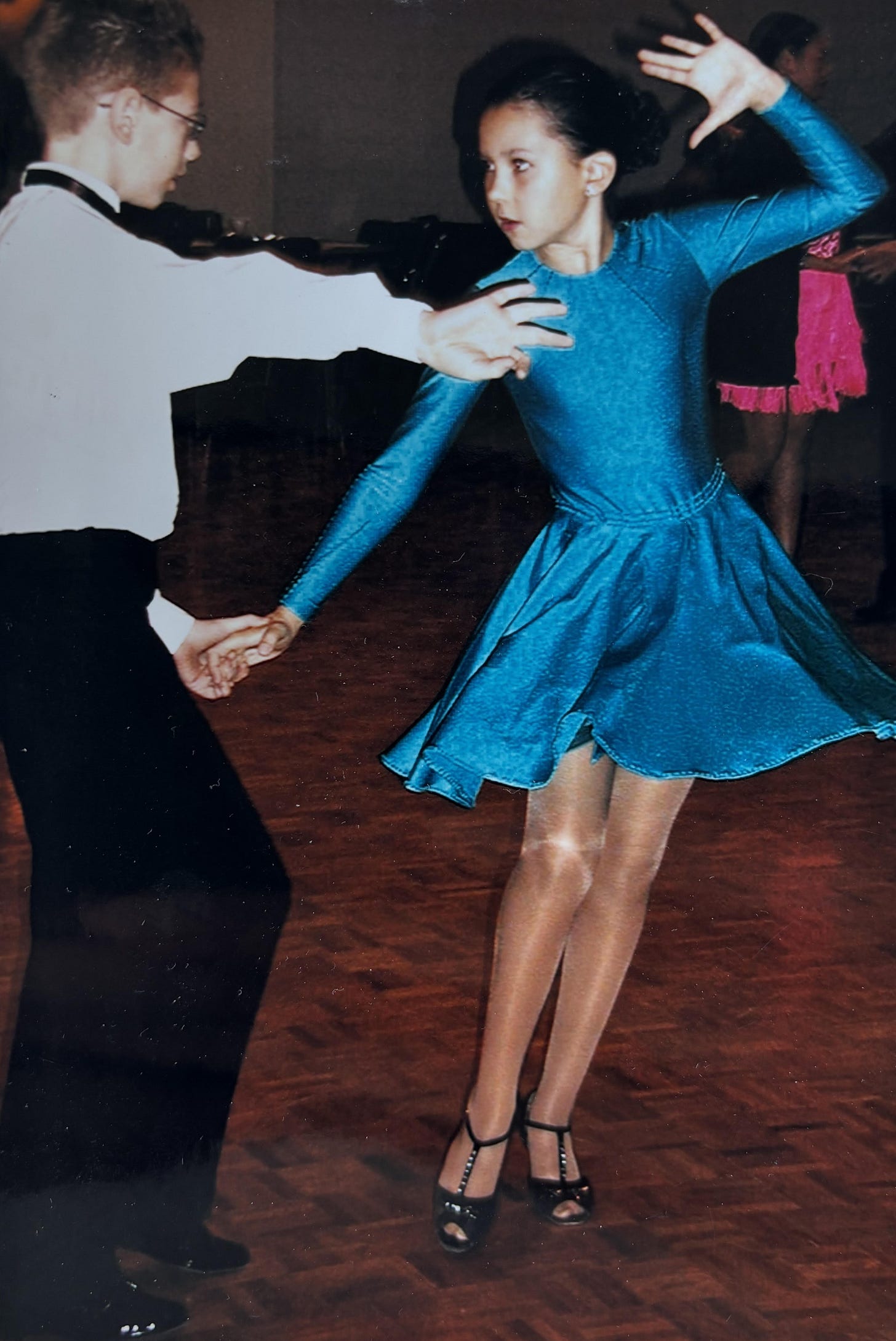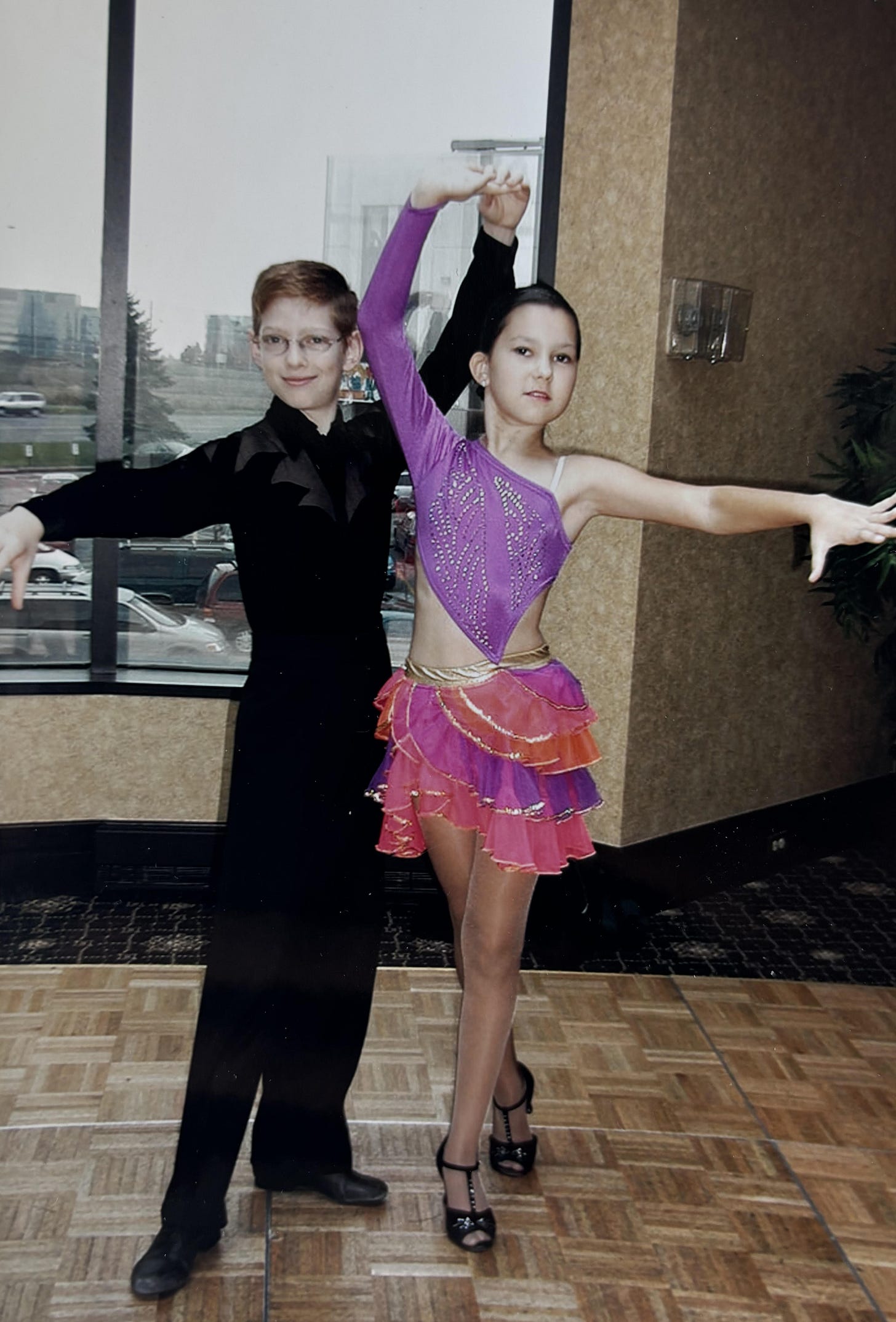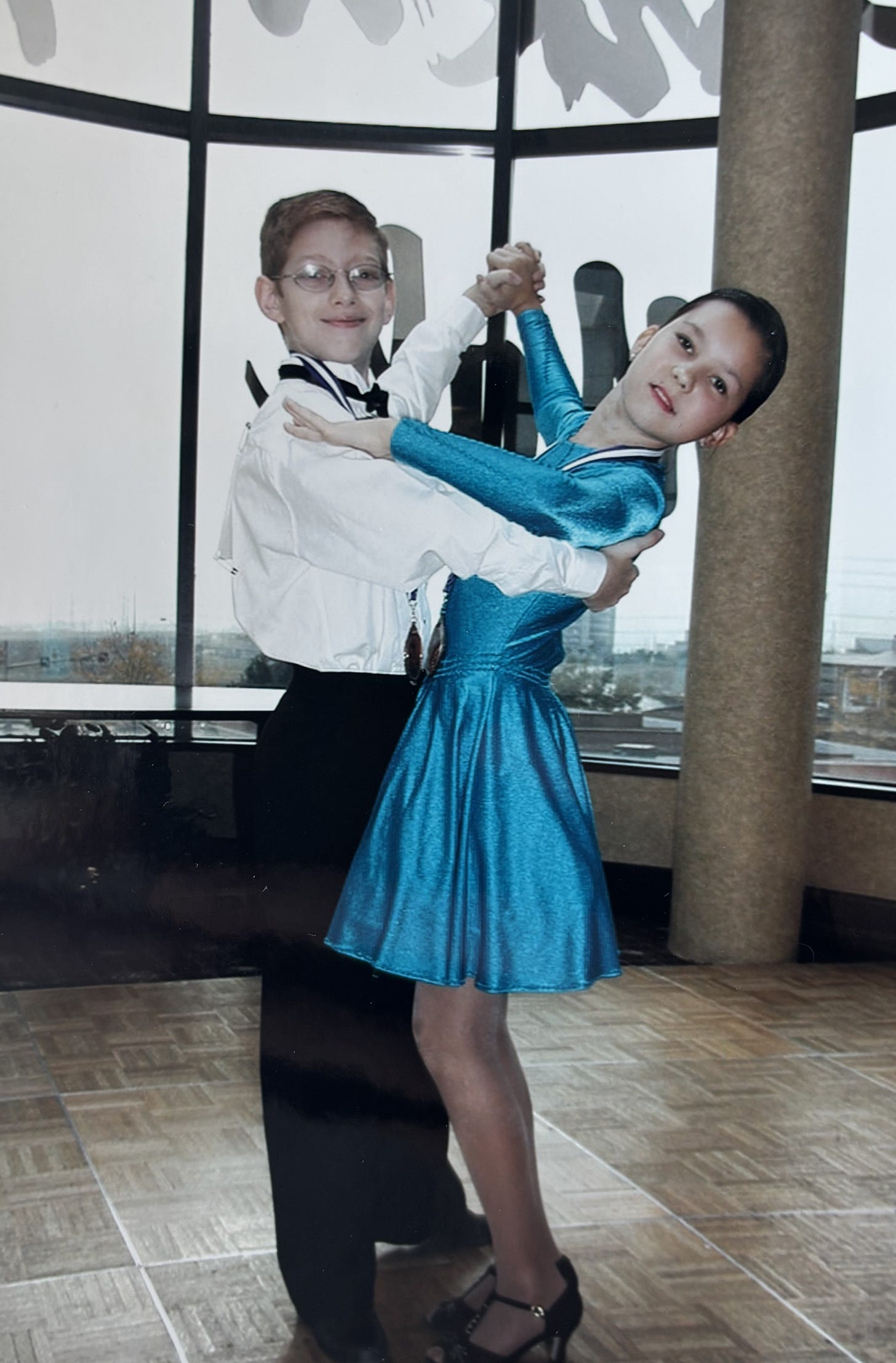My mom always tells me that as a toddler, I couldn’t go by music without stopping to bounce. I’m still like this – I hear upbeat tempos and I have to move. It must be a good thing that I spent the majority of my childhood in Russia, where dance was integrated into the school curriculum. Even if it wasn’t, I was also part of an afterschool program for dance, music, the performing arts, English and French, and thus got plenty of dance and performance time in. But, at school in first grade in Russia, in our second semester, we were given the option to choose between a traditional folk dance class, or a new program in the curriculum, Ballroom and Latin Dance.
My parents are the ones that suggested I go the Ballroom route – in asking my mom why for this essay, she said it’s because ballroom dance was becoming very popular in Russia. All I remember is that I could keep up and liked it, and when the instructor invited me to join his dance company to prepare to start competing, we agreed.
I started taking ballroom dance lessons to train competitively in the summer of 1999. In August of that year, we immigrated to Toronto. Maybe a year after we got settled in, my parents found a ballroom dance instructor and signed me up for lessons, and I started to compete at the age of ten. I took group lessons in the suburbs of Toronto, Richmond Hill, where my dance teacher had a studio in the basement of her house. There were maybe eight or ten other kids – all of them Russian-speaking immigrants – some my age, some younger, some in high school. Being a part of this community, and doing something I knew I was good at, gave me a lot of comfort and familiarity in an otherwise uncomfortable period of assimilation.
Some background here on ballroom dance. There are two kinds: Standard and Latin. Standard focuses on slower dances – waltz, foxtrot – and emphasizes elegance, grace, posture, and fluidity of movement. Latin is high tempo – Cha-Cha, Jive, Rhumba, and Samba – and focuses on vibrant energy and a kind of personal flair.
Then there are the levels of competition, for both Standard and Latin: Newcomer, Bronze, Silver, Gold, and then Pre-Championship and Championship. I danced within Bronze and Silver for most of my competitive career.
Here is a terrific example of the highest level of ballroom dance – Max Kozhevnikov and Yulia Zagoruychenko. They were the best in the biz when I was in college and they make it look so easy. It’s not.
From the video, perhaps you can surmise that the key to both styles and all levels is two-fold: your partnership and your performance energy. You cannot dance solo, and having a partner is even required for practice. I don’t quite remember how finding a partner worked – the instructors would suggest someone with a potential height and skill match, and we would have a practice session together. I remember dancing with one boy who I thought was super cute, but whose skill level exceeded mine – disappointing, but then when I finally was matched up with a partner where our skills aligned, it was a relief and I looked forward to practice.
In terms of performance energy, I definitely recommend for you to watch the video above if you haven’t yet. Look at their faces and note their level of energy. Don’t they look like dancing is their favorite thing in the world, and that they’re so happy to be there?

To win a competition, many factors were at play. Our technique, of course, but that was just the bare minimum. In addition to technique and getting the dance routine right, we also needed to stand out to the judges (via costumes mostly), project a certain confidence, and smile while dancing — this is where the performance quality is essential.
I remember loving ballroom dance, but the sport was challenging. I was always needing to improve something in my technique – moving my hips and not my shoulders, pointing my feet properly and straightening my legs well where appropriate, having upright and elegant posture always – and I also needed to rely on my partner to do his part as well. If one of us made a mistake, both of us made a mistake. And because I took a lot of care in making sure my technique was good and that I memorized the routine well, mistakes not on my part were frustrating.
Another key background element to ballroom dance: it is expensive. Group lessons are costly in the first place, and if you really want to improve and advance, you need to take private lessons, which are even more expensive. There are costs for driving to and from lessons. Then competition entry fees. Then costumes – custom costumes, each for ballroom and standard, as well as shoes. And, since I was dancing as a growing child, these needed to be updated every season. The cost of it all was a setback for me and my family – we were new to Canada, came with a lot less than we thought we would, and I knew my parents were already making all kinds of sacrifices financially so that I could dance.
Memorizing a routine, or putting on a show, wasn’t a problem for me (not then at ten years old, not now either). Mastering the technique was ultimately doable too – though after a certain time, there is only so much you can improve without private lessons, and my parents just couldn’t afford it.
But the biggest struggle I had was in partnership. I would have a really hard time when my partner made a mistake, or when we messed up the routine because of something that couldn’t quite stick with them. I’m not saying I was always perfect with my steps, but I do remember all of the times I would get mad when I wasn’t responsible for the mistake. One day even, I was so upset that I locked myself in the bathroom in the dance studio to pout, and my partner felt lost as to what to do. According to my mom, he was asking his parents and mine what he could do to make me feel better. He was such a nice boy, and always kind to me, and I wish I knew then to communicate better and also to have more empathy if someone was struggling with something that maybe came a little more easily to me.
I stopped dancing when I went to high school, and we moved to Colorado shortly after. In high school in Canada, I was on the basketball team, but when we moved to Colorado and the US teams were much more athletic and competitive, I opted for individual sports – cross-country, swimming, and track. This kept me happy, healthy, and some rhythm had stayed in my life. I was so busy, I wasn’t sure if I missed competitive dance per se, but I definitely missed dancing more.
Then, in architecture school, I found out that Cornell had a ballroom dance team! I joined my first year, and met one of my favorite people to this day – one of my best friends, and mentors, Jenny. Jenny was a fifth year architecture student, and was dancing at the highest level in the competitions. She was so cool, and still is, and joining the team was worth it just for that.
But it’s dancing at the college level, and hopefully this means I matured some, where I took joy in the partnership aspect of dance. With how intense and competitive architecture school was, I found solace, rather than the frustration as I had as a kid, in my partnership. I danced with two people during this time, first Olson and then Oleg, and it was comforting to be away from studio and involved in something together with a team, and then more closely with my dance partners.
Both Olson and Oleg majored in something other than architecture, so dancing with them was a reprieve in that we could focus on dance and talk about things beyond what I spent the rest of my day on. They were both very kind and committed to practicing, and I could rely on them both to show up and dance so that we could both improve. Olson was a less experienced dancer than I was, but so nice and enthusiastic to learn and improve, that by this point, in thinking back to me as a kid getting frustrated with my partner, I did develop that sense of empathy and we worked on whatever he/we needed to, together. Oleg was an experienced ballroom dancer, maybe even more so than I was, so I remember our practices always going smoothly and him being very kind as well.
Now that I write this, it doesn’t sound groundbreaking – this is just simple teamwork, being in the trenches together with someone. But somehow, because it was for something outside of our primary focus, i.e. our college majors, that partnership for the sake of joy and enjoyment became very special. I never ever remember getting frustrated with either of my college dance partners, and I’m sure we both made mistakes in our routines. I only remember dance in college being fun. Eventually though, I went abroad for a year, and then didn't want to dance in my thesis year as I was really focused on my studio work and landing a job after graduation. I haven’t danced ballroom since (except for once at a party in New York, where a fellow guest started breaking out in cha-cha, and we danced together…I still remember all the steps, the muscle memory is real!).
I get the same joy from running while listening to house music, or from a Barry’s HIIT class – both of those activities feature a prominent beat, which I need after loving dancing to one for so long – and feel that I get the energy and boost that I used to from competitive ballroom dance. I am trying to dance more in 2025, in general, because it makes me so happy.
But my takeaways from writing this essay and reflecting back on my time with ballroom dance is that whenever you are in a competitive environment — be it a dance competition, college or job applications, interviewing as a firm when interviewing for an architecture project — technique and skill (your dance technique, your resume, your portfolio) are just table stakes. Most everyone you are competing with has those. It’s what you bring beyond that — your energy, your chemistry with your partner(s), your motivation for competing, your very human qualities — that will really set you apart. And I’ve found that the people that are successful in competitions are the people that are really in it, all the way — they want it, they know why they do, they want it together (if you are competing with a team), and they’re not afraid to show their enthusiasm.



